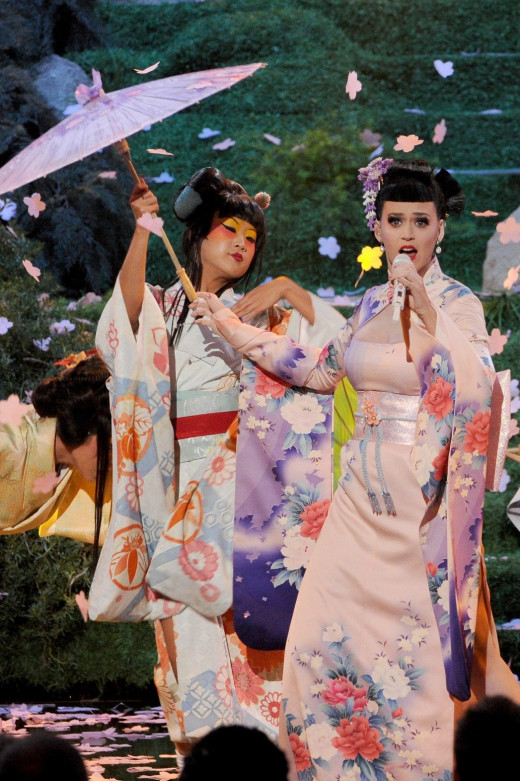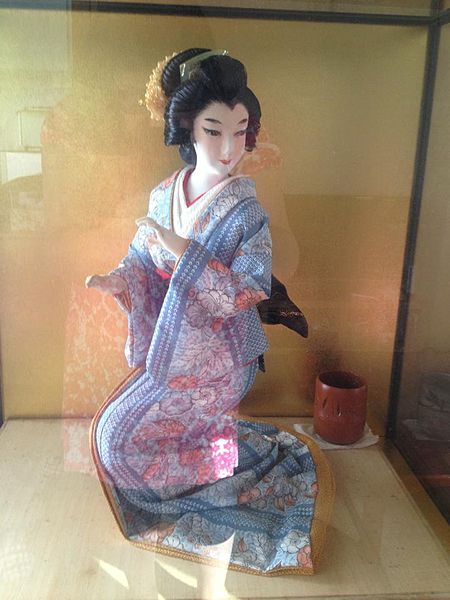Why Do People Say That Katy Perry's 2013 AMA Performance Was Racist?

Wait, why are you writing this instead of your usual history stuff?
I've taken a short break from my regularly scheduled 'History of Kimono' series to address an appearance of kimono in recent entertainment news.
American pop princess Katy Perry made waves with her AMA performance of her hit single 'Unconditionally' from her new album Prism. The opening act of the night, Perry's performance featured Japanese backdrops and traditional elements, such as kimono, torii gates, sakura trees and taiko drumming. The performance was described as beautiful and colorful by every major media outlet, and was decried by bloggers and tweeters for being racist. Why the stark contrast in opinions?
Hey, Wikipedia, what is 'Racism'?
"Racism is generally defined as actions, practices, or beliefs that consider the human species to be divided into races with shared traits, abilities, or qualities, such as personality, intellect, morality, or other cultural behavioral characteristics, and especially the belief that races can be ranked as inherently superior or inferior to others, or that members of different races should be treated differently."
Wikipedia samples that definition from the Oxford Dictionary Online:
"The belief that all members of each race possess characteristics, abilities, or qualities specific to that race, especially so as to distinguish it as inferior or superior to another race or races."
Note that neither of these definitions include 'hatred' in them! That's important.
What is 'Racism', and why is this performance 'racist'?
The word 'racism' conjures up very visceral images of white-hooded men burning crosses, of Dr. Martin Luther King Jr. being arrested and peaceful protesters being blasted with firehoses, of people being herded into gas chambers and then thrown into incinerators. In comparison, modern cries of 'racism' seem like someone invoking Godwin's Law. Indeed, Miley Cyrus twerking on the VMAs was called 'racist' by some, which was dismissed by the majority of people as wildly exaggerating the non-issue of her dance routine.
The common usage of 'racism' implies hatred of another ethnic group (though people will often ignore even the ethnic component of racism, which, ironically, is racist!), but that is not the only facet of racism. Stereotypes descend from racism, comedy can originate in racism, and, most relevant to this article, ignorance can lead an otherwise fair person to say or do racist things. A more academic definition of 'racism' includes those possibilities because racial hatred and fear stems from these ideas, not the other way around. (After all, one cannot hate or fear a certain ethnic group if they don't think that they all share certain undesirable characteristics--otherwise, they are hating or fearing an individual who happens to be of a certain ethnic group, not because they are of that ethnic group.)
I said earlier that ignorance is a root for racist actions and remarks, and that is what is most relevant in the case of Katy Perry's AMA performance. I don't think that Katy Perry is a racist or bears racial hatred against any group (she is a very accepting and open person, after all)--but she, like many other Americans without formal education, is ignorant of minority issues in America, of international issues, and the history of Western imperialism and Orientalism. Her lack of knowledge about these things means that she doesn't understand where her cultural perception of Asia comes from, and makes her say and/or do racist things unintentionally. The AMA performance by Katy Perry was racist and sexist due to its Orientalist theme and stereotypical imagery coupled with the song choice.
The Performance
'Frozen in amber'
Orientalist attitudes are, according to Saïd, based on the idea that Middle Eastern and Asian cultures stopped developing at some point and have thus remained static for centuries while European nations advanced in art, science, literature and philosophy. This view is simply not true, but to the armchair anthropologists and museum curators of the 19th century, this was a very scintillating idea. Being able to display something made 'in the traditional style, just as it would have been done hundreds of years ago' is an intensely Romantic notion, and one which got a lot of people coming into the museums to see these exotic pieces of Oriental art. The problem with this is, of course, that it denies that any other cultures are 'developed' unless they look like Western cultures and have followed the same historical steps. By identifying Asian cultures as 'undeveloped', it justified the colonization and subjugation of Asian nations.
A modern example of this practice can be seen in Tibet. After the Chinese took control of Tibet in 1950, a suppression of Tibetan cultures was carried out. China maintains many locations of religious and cultural significance relating to various Tibetan cultures, but has opened them as museums. By placing the cultures of Tibet in a museum setting (and by transforming the dozens of unique cultures of the Tibetan plateau into one monolithic 'Tibetan culture'), they are implying that it is 'frozen', no longer developing, old, and dead.
What is 'Orientalism'?
'Orientalism' is a term which originally arose in the art world to describe art depicting the Middle East and Asia. Such themes were particularly popular in the 19th century, enough to make 'Orientalism' a recognized artistic movement. However, a landmark book by Edward Saïd applied the term to a general Western perception of the Middle East and Far East which grew out of Western Imperialism (making the artistic movement a direct result of the 'Orientalist' mindset).
This socio-cultural definition of Orientalism is thus defined as the romanticizing of the Eastern world as exotic, beautiful and Other, while simultaneously being backward, undeveloped, quaint and static. Orientalism is, by definition, a racist attitude, but it is not one which promotes racial hatred. An Orientalist will want to have a Persian rug or a Ming vase to decorate their house, or will purchase a Tibetan thangka painting or a sculpture of the Buddha as decorative art objects completely divorced from their religious purpose. An Orientalist will admire these pieces that they have collected as beautiful and exotic, but the Orientalist is condescending in their admiration, like an adult being 'impressed' by a child's macaroni necklace or stumbling recitation of Dr. Seuss. The cultures which produced those 'Oriental art objects' are seen as some sort of cultural living fossil that stopped developing some time in the middle ages, that never had a Renaissance or an Enlightenment or an Industrial Revolution, and are therefore inferior. Orientalism is, in this context, a diminishing of Asian and Middle Eastern cultures while simultaneously 'celebrating' their aesthetics, to the point where their aesthetic products 'become' that culture. It is divorcing the objects of admiration from the rich culture that produced them, treating holy objects as mere decoration, and the appropriation of elements of culture or philosophy as accessories for a Western person to put on or take off with any given outfit. Thus, the romanticizing of harems, the ooh-ing and aah-ing over Ayurveda, the 'casual obsession' that many Western youths have with Japan, and Hollywood stars 'totally being into Buddhism and yoga and Kaballah and stuff' are all manifestations of this Orientalist attitude.
In light of this, it's obvious how Katy Perry's performance is Orientalist. Her backup dancers were dressed in modified kimono and minced around the stage performing Indian 'Namaste' gestures while wearing crazy Sailor Moon-style updos and Chinese opera-style makeup designed to make them look Asian--very few of her backup dancers were actually of Asian descent. Katy Perry and her designers put together this performance because they wanted that 'exotic Asian' aesthetic, and didn't dedicate much time to authenticity (which is often justified by pointing out the trivial fact that 'they're not making a documentary here'). The inspiration and execution was Orientalist, which has racist implications.
I'll take this moment to reiterate that I don't think Katy Perry is hatefully insulting Asian cultures--she is merely ignorant of them, and her concept of Asian cultures has descended from Orientalist Western stereotypes which she was exposed to in her life as a privileged American girl. She is a decent human being, but she DID something racist out of ignorance--I think if someone would have informed her of this issue and the issues below, she wouldn't have put this performance on.
Okay, so she thinks Asian things are pretty. Why is that a problem?
When I first saw the AMA performance (the night after the AMAs aired and only after I started to get whiffs of the outrage in the blogosphere), I could immediately identify that there was something wrong with it, something besides the cultural appropriation...but I couldn't put my finger on it. It wasn't just that Katy Perry was wearing a Chinese cheongsam made out of a Japanese kimono (and then constantly referred to as 'a kimono' in the media), or that all her backup dancers were wearing similarly ruined (I'm sorry, modified) kimono, or that her portrayal of Japanese culture was taken entirely from travel brochures and tourist traps looking to capitalize on those sweet, sweet Orientalist dollars. In fact, it took me a couple of days before I realized what, exactly, was wrong with it (and then happily discovered that I was apparently the last feminist on Earth to realize the problem, once I started reading some blogs).
Katy Perry's performance was racist and sexist.
Again, I'm not saying Katy Perry is a horrible, evil sexist! I'm saying she DID something sexist...and again, she did it out of ignorance regarding the experiences of women of color and the history of Imperialism in Asia.
I currently live in America, and I am Caucasian. When I experience sexism, it's always plain, vanilla-flavored sexism, directed solely at the fact that I'm a woman. But for women of color, their experience of sexism is also colored (pardon the pun) by racism. There are additional stereotypes leveled at them because of their ethnicity, and often these racial stereotypes can't be separated from their gender (e.g. the stereotype of the ratchet black Welfare Queen living in the projects, Latinas are either poorly educated maids/nannies who are in America illegally and can't speak English, or they're hypersexualized spicy nymphomaniacs, etc.). Asian women suffer from a racist/sexist double whammy as well...and it's one that Katy Perry exploited in her AMA performance.
Asians suffer from many stereotypes, both negative and positive. The stereotypical, monolithic 'Asian culture' is seen as exotic, but also strange, incomprehensible and rigid (the Orientalist perspective), and Asian-Americans are viewed as 'perpetual foreigners'. It's not unusual for someone to ask an Asian-American 'where they are from' or 'what their native language is', even if their family has lived in America for generations. They are also held up as a 'model minority' in America--the stereotype holds that Asians (with no distinction between ethnicities) are hard-working, intelligent, quiet, apolitical and hyper-respectful, so therefore they're 'better' than other minorities. Of course, even positive stereotypes are harmful--if you are Asian, you are expected to be studious and good at math and the violin, and if you're not, your identity as an Asian is called into question. The 'model minority' label also downplays the racism and challenges that Asians still face, because the perception is that they 'don't have real problems' like non-Asian minorities do. Asian women and Asian men suffer from somewhat interconnected sets of stereotypes, but for the purpose of this Hub, I'll be focusing on the stereotypes of Asian women in particular.
There are two primary stereotypes of Asian women, both of them hypersexualized. The first, the Dragon Lady, is highly aggressive (to contrast the stereotype of Asian men as effeminate, asexual and weak), both sexually and socially. The second, which Katy Perry has latched on to, is the 'China Doll', the 'Madame Butterfly', the 'delicate lotus blossom', or as Perry was described, the 'Geisha girl'. This stereotype is of a delicate, shy, demure, submissive, exotic woman who (also in accordance with the stereotype of the asexual, weak Asian man) longs for a white man to serve. This stereotype has been intensely eroticized in the West as a counter to the Feminist movement, and having an 'Asian fetish' is considered common in the West. Perry adopted this stereotype for her performance without consideration for how harmful this stereotype is to real Asian women all over the world.

What makes the 'China doll'/'Geisha girl' stereotype so harmful?
Much of what I came to realize during my self-imposed exile from the blogosphere regarding the harmful stereotypes of Asian women was well said way before me over at Afternoon Snooze Button, and I would be remiss if I didn't send you there before the end of this article. Asian women of all ethnic backgrounds are objectified as 'China dolls'/'Geisha girls' (until they demonstrate a trait associated with the 'Dragon Lady' stereotype, of course).
The fetishization of Asian women is colloquially known as 'Yellow Fever', and is the reason why women of Asian descent are the most trafficked minority in America--between 30-50% of victims of human trafficking in America in 2004 were women or girls of Asian descent (which translates to between 5,000-8,000 women and girls). Women are often trafficked within Asian countries, as well--many women from the Philippines and elsewhere are lured to Korea and Japan with promises of pop stardom, but end up being exploited in 'Juicy bars' or in Yakuza-run sex clubs, and North Korean refugee women escaping into China often find themselves victims of the sex trade as well, sold as brides to Chinese men or put into brothels, threatened with repatriation to North Korea if they disobey or try to escape. Asian countries are some of the prime destinations for 'sex tourism', where women and girls are forced into prostitution to wealthy men--often foreigners from the West. Women of Asian descent are also the most likely to suffer physical or sexual abuse in an intimate relationship; numbers range from 41-61% of women of East Asian or Southeast Asian descent, with women of Indian, Pakistani and Filipina ancestry reporting similar numbers. And perhaps more worrying, in a 2002 study by Jeniffer Lynn Gossett and Sarah Byrne of violent internet pornography, over half of the websites surveyed depicted Asian women being raped.
This perception of Asian women as objects to be abused is exacerbated in the case of Katy Perry's AMA performance by her song choice. She could have sung just about any other song, and this performance would have been just a little bit weird and kind of racist. But the song she sang, 'Unconditionally', includes lyrics suggesting 'weathering the storm' when one's love is having one of their 'bad days', insisting the singer will love their partner 'unconditionally'--common sentiments found among victims of abuse by intimate partners. The attitude of the song, coupled with the portrayal of the submissive Asian woman stereotype, welcomes that treatment.
Katy Perry has a large amount of influence due to her popularity--her portrayal of a woman in a restrictive, eroticized "traditional Asian dress" promising to love her partner 'Unconditionally' plays up the China Doll/Geisha girl stereotype, lending support to the mindset that this is what it means to be an Asian woman, even though Katy Perry herself is not Asian. This image of 'Asian women' was broadcast all over the world to millions of viewers, including to her young fans, many of whom undoubtedly are of Asian descent. This image influences their view of themselves, and influences other's view of them--including men's view of those Asian girls.
And sadly, at the same time, millions of women and girls are unable to raise their voices and tell their experience of what it means to be a woman, to be an Asian woman, to have this image of 'Asian femininity' forced on them if it is not their choice. Many are being exploited as victims of the sex trade in third-world conditions. Many more are living in cities and towns, being objectified by people who pass them on the street, abused by partners, harassed in public because their ethnicity makes them targets for unwanted sexual attention--and many have little legal recourse, because they cannot identify their harassers or attackers, or because such crimes against Asian women are often not counted as a 'hate crime', even in cases of serial rapists who admit to only targeting women of a specific ethnicity for their attacks. And none of these women have the sort of platform and public attention that Katy Perry has in order to tell their stories and shed light on these problems.
There is hope, however! Katy Perry is already widely known as an LGBT Ally, and has recently been named a UNICEF Goodwill Ambassador, where she will undoubtedly come to face many of the issues which young people of color live with, including the issues faced by Asian women and girls. She is a very generous, caring person--her only fault is her lack of education on this subject. If Katy Perry takes the time to learn about this issue, she will surely become an ally for suffering women and girls all over the world. Ignorance is only shameful if you do nothing to correct it; if someone takes the time to teach Katy Perry about the harmful stereotypes that she has unwittingly bought into, I'm sure she won't make such a tasteless mistake again.
So what, can nobody wear Asian clothes if they're not Asian or something?
Not at all! This is another related issue, called 'cultural appropriation'. Orientalism is a form of cultural appropriation relating to the Middle East and Asia, but any culture can be appropriated in any location where they are a minority.
Can a non-Asian wear traditional Asian clothing without being appropriative? Absolutely! As someone who has devoted several years to studying, collecting, and wearing kimono, I think that kimono can make anyone of any age, ethnicity or body type look beautiful and elegant if it is worn properly. Special attention must be paid, however, to ensure that you are wearing kimono--or any traditional garment from anywhere--in an appropriate, proper manner, in accordance with the rules, traditions and customs associated with that clothing. Katy Perry and her backup dancers fell down flat in this area, taking a garment with a lot of cultural significance and modifying it to make it 'sexier' and more appealing to the Western male gaze, creating a costume which is worn as an accessory, without respect to the cultural place the kimono holds.
Kimono, while an inspiration for fashion, are nowadays rarely worn either in or outside of Japan. The garment has become wrapped up in so many rules and expectations that even Japanese people are intimidated by their national dress. Most people's experience with kimono is related to ceremonial events such as graduation, weddings, and Seijin-no-Hi ('Coming-of-Age Day'), where professional kimono experts must dress the celebrants, and the 'vocabulary' of kimono is so nuanced, they feel they could never learn how to properly wear kimono. Many people in Japan are impressed by young people who have an interest in kimono and even more so by people who are able to properly wear the extremely complicated garment, no matter what their nationality. (There are exceptions, of course--Japanese Nationalism is still alive in Japan, and people who follow that ideology consider Japanese culture as 'for the Japanese' only.) The identification of kimono with 'Japanese-ness' necessitates a lot of respectfulness and study in the wearing of the garment, but it is a 'uniform' for many traditional Japanese arts, and learning how to put together a harmonious outfit and then wear it is an art in and of itself.
It is always best to make sure you have permission to wear such garments, especially if you are going to be wearing them in a place where people of that culture will be present. Certain articles of clothing or jewelry may have particular religious/historical/cultural ties which may make wearing them distasteful (such as a crested solid black unpatterned kimono) or forbidden to people who are not members of that group (such as feathered war bonnets). It is important to have a thorough understanding of the traditions associated with that mode of dress in order to avoid wearing something which may be distasteful or disrespectful. By educating yourself about a specific kind of clothing and wearing it appropriately and respectfully, you are in a position to truly show an appreciation for that culture and its traditions--but you must always be careful about such things, and be sensitive to the requests of members of that culture. Some people may not want you to 'play dress-up' with their culture no matter how much effort you put into accurately reflecting it, and will request that you not wear such things in the future. No matter how much of a spoil-sport they might seem to be, you should honor their request--don't argue with them about your "right" to wear THEIR culture. And when in doubt, don't wear it!
What about reverse cultural appropriation?
There is no such thing. Something either is cultural appropriation or it is not, and only an empowered, privileged group can be an appropriator When the disempowered, discriminated group takes things from the dominant group, that is assimilation; it is something that they must do in order to be accepted by the empowered group, and it is often forced on them. There is one good example that I've heard get cited as 'reverse cultural appropriation', but in reality, it's just regular cultural appropriation. That example is Catholicism in Japan.
In the West, Christianity--Catholicism in particular--has enjoyed a long history of cultural dominance in Europe, but historically, Catholics have been an oppressed minority in Japan. Catholics were brutally persecuted by the Japanese government for almost 300 years, and even today, Catholics make up less that 0.5% of the population. The trappings of Catholicism (such as rosaries, images of the Sacred Heart and the Virgin Mary, nun's habits and priest's cassocks worn by anime and manga characters, 'Christian Weddings' performed by non-Christians for non-Christians, etc.) are often appropriated by non-Catholic Japanese youth and subcultures for purely aesthetic purposes to create a feeling of 'foreign-ness' or to play up their common association with the Gothic aesthetic. Many Christians I met in Japan felt uncomfortable seeing non-Christian Japanese people wearing their holy symbols as fashion statements--some went so far to say that it was disrespectful (and in some cases, such as a rosary with an upside-down crucifix, there could be some clearly disrespectful image involved--though the Japanese teenager wearing it would have no idea that their 'rock star necklace' is offensive!). As far as I can see, this is cultural appropriation.
However, a Japanese businessmen wearing a business suit is NOT appropriation; not only is the suit being worn in its original context, but the association between a suit and business is an example of cultural dominance and assimilation; it has displaced traditional clothing as a symbol of power (thus making traditional clothing 'primitive' and 'uncivilized'), and is considered the only acceptable clothing to be worn in a Western-style office culture. A person of color cannot reasonably expect to show up to the office in the traditional clothing of their culture and expect to be allowed to wear it, because suits are a uniform. The business suit as a uniform for people who wish to work in high-paying, white-collar professions is a cultural idea from the economically dominant West which has been assimilated into many cultures around the world in an attempt to be taken seriously. (T-shirts and jeans have been similarly assimilated--to wear traditional clothing is to risk being seen as 'Other', 'primitive', 'uncivilized', or 'poor'.) There is a wonderful Tumblr post on this topic over at My Culture Is Not A Trend.








